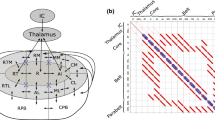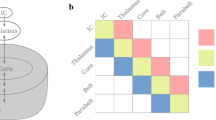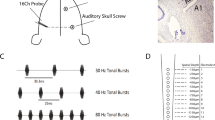Abstract
The auditory evoked potentials and fields, recorded with electro- and magneto-encephalography, respectively, have the prominent peak at the latency of about 100 ms, named N100(m). The mechanism for generating the peak is not yet fully elucidated, however. Firstly, this study reviewed empirical results on the mechanism that had been previously published by the same author. The results showed that phases of the ongoing oscillations at around 6 Hz above the auditory cortex are locked with respect to onsets of the auditory stimuli during the period of N100 m, and also that powers of the oscillations are increased during the same period. Taking into account these results as well as another evidence that the peak arises from multiple sources within the auditory cortex, a model for the mechanism of generating the auditory N100 m was proposed. The model assumed several oscillators in the auditory cortex, whose phases were locked during the period of N100 m, but not locked at other periods. Computer simulation validated the model. The model could represent a starting point for further experiment and simulation.
Similar content being viewed by others
References
Beagley HA, Henshall WR (1974) The mechanism of auditory evoked EEG responses. Nature 247:481–483
Cacase AT, McFarland DJ (2003) Spectral dynamics of electroencephalographic activity during auditory information processing. Hearing Res 176:25–41
Godey B, Schwartz D, de Graff JB, Chauvel P, Liégeois-Chauvel C (2001) Neuromagnetic source localization of auditory evoked fields and intracerebral evoked potentials: a comparison of data in the same patients. Clin Neurophysiol 112:1850–1859
Hamada T (2005) A neuromagnetic analysis of the mechanism for generating auditory evoked fields. Int J Psychophysiol 56:93–104
Hämäläinen M, Hari R, Ilmoniemi RJ, Knuutila J, Lounasmaa OV (1993) Magnetoencephalography – theory, instrumentation, and applications to noninvasive studies of the working human brain. Rev Modern Phys 65(2):413–497
Jansen BH, Agarwal G, Hegde A, Boutros NN (2003) Phase synchronization of the ongoing EEG and auditory EP generation. Clin Neurophysiol 114:79–85
Jervis BW, Nichols MJ, Hohnson TE, Alllen E, Hudson NR (1983) A fundamental investigation of the composition of auditory evoked potentials. IEEE BME 30(1):43–49
Kolev V, Yordanova J (1997) Analysis of phase-locking is informative for studying event-related EEG activity. Biol Cybern 76:229–235
Kolev V, Yordanova J, Schürmann M, Basar E (2001) Increased frontal phase-locking of event-related alpha oscillations during task processing. Int J Psychophysiol 39:159–165
Mäkinen V, Tiitinen H, May P (2005) Auditory event-related responses are generated independently of ongoing brain activity. NeuroImage 24(4):961–968
Näätänen R, Picton T (1987) The N1 wave of the electric and magnetic response to sound: A review and an analysis of the component structure. Psychophysiology 24:375–425
Pantev C, Bertrand O, Eulitz C, Verkindt C, Hampson S, Shuierer G, Elbert T (1995) Specific tonotopic organizations of different areas of the human auditory cortex revealed by simultaneous magnetic and electric recordings. Electroencephalogr Clin Neurophysiol 94(1):26–40
Pictons TW (1974) Human auditory evoked potentials I: evaluation of components. Electroencephalogr Clin Neurophysiol 36:179–190
Reite M, Adams M, Simon J, Teale P, Sheeder J, Richardson D, Grabbe R (1994) Auditory M100 component 1: relationship to Heshchl’s gyri. Cog Brain Res 2:13–20
Salajegheh A, Link A, Elster C, Burghoff M, Sander T, Trahms L, Poeppel D (2005) Systematic latency variation of the auditory evoked M100: from averaged to single-trial data. Neurolmage 23:288–295
Semple MN, Scott BH (2003) Cortical mechanisms in hearing. Curr Opin Neurobiol 13:167–173
Singer W, Gray CM (1995) Visual feature integration and the temporal correlation hypothesis. Ann Rev Neurosci 18:555–586
Tokioka R, Kawaguchi H, Fukunishi K (2000) Spatio-temporal analyses of stimulus-evoked and spontaneous stochastic neural activity observed by optical imaging in guinea pig auditory cortex. Brain Res 861(2):271–280
Tiihonen J, Hari R, Kajola M, Karhu J, Ahlfors S, Tissari S (1991) Magnetoencephalographic 10 Hz rhythm from the human auditory cortex. Neurosci Lett 129(2):303–305
Yvert B, Fischer C, Bertrand O, Pernier J (2005) Localization of human supratemporal auditory areas from intracerebral auditory evoked potentials using distributed source models. NeuroImage 28:140–153
Author information
Authors and Affiliations
Corresponding author
Rights and permissions
About this article
Cite this article
Hamada, T. A model for the mechanism of generating the auditory evoked field. Biol Cybern 94, 143–148 (2006). https://doi.org/10.1007/s00422-005-0033-9
Received:
Accepted:
Published:
Issue Date:
DOI: https://doi.org/10.1007/s00422-005-0033-9




